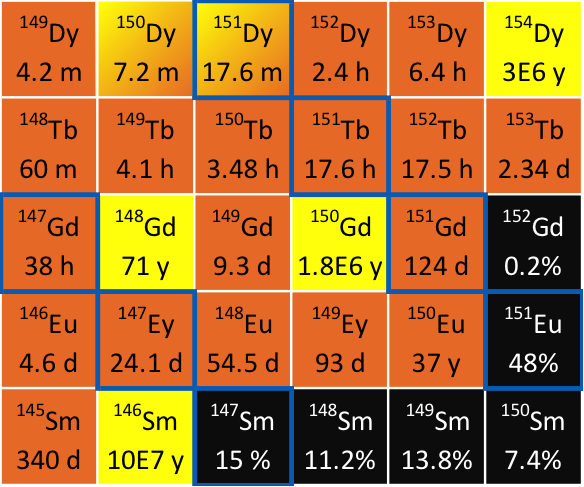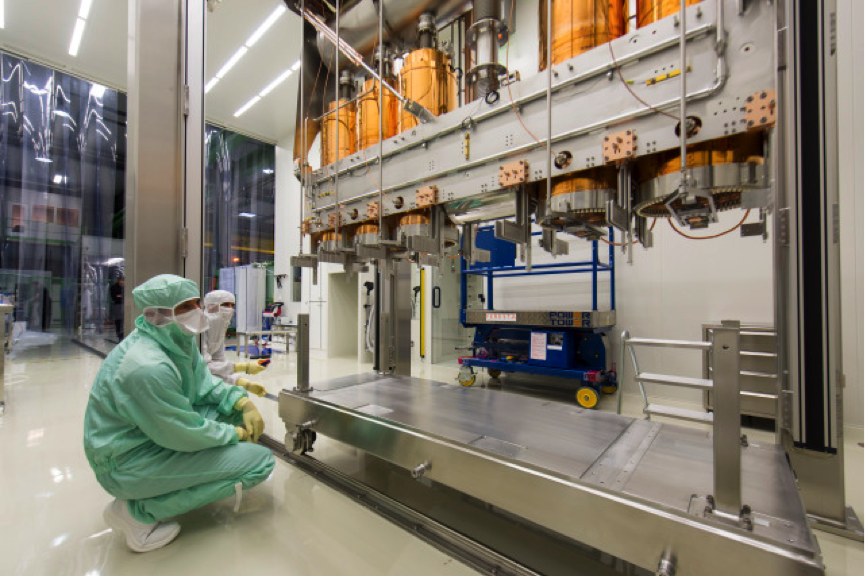A boost for ISOLDE's beams
The new HIE-ISOLDE accelerator is up and running, increasing the beam energy of ISOLDE, CERN’s nuclear physics facility.
Over the last few weeks, CERN's nuclear physics facility, ISOLDE (http://home.web.cern.ch/about/experiments/isolde), has been producing ion beams at higher energies. The first cryomodule of the new HIE-ISOLDE (High-Intensity and Energy ISOLDE) accelerator is up and running, increasing the beam energy from 3 to 4.3 MeV per nucleon.
The unique ISOLDE facility accelerates different types of radioactive ions for many fields of fundamental and applied research. Each year, its beams are used by around fifty experiments studying a wide range of subjects from the properties of atoms and nuclei to biomedical applications, nuclear astrophysics and solid-state physics. By producing higher-energy beams, the HIE-ISOLDE accelerator will increase the research opportunities further.
These first beams are the result of eight years of development and manufacturing. The assembly of this first cryomodule presented CERN’s teams with numerous technical challenges. It contains five accelerating cavities and a solenoid magnet that focuses the beam, all of which are superconducting. The cavities were particularly complex to build, and the cryomodule is made up of no fewer than 10 000 components! It was transported to the ISOLDE hall on 2 May and coupled to the existing accelerator. The commissioning began in the summer, culminating in the acceleration of the first radioactive beam on 22 October.
HIE-ISOLDE will run for a total of five weeks this year. Next year, another cryomodule will be coupled to the first, increasing the energy to 5.5 MeV per nucleon. The installation of the final two cryomodules will begin in mid-2016, bringing the final energy to 10 MeV per nucleon for the heaviest nuclei generally produced at ISOLDE.
The first cryomodule of the new superconducting linear accelerator HIE-ISOLDE (High Intensity and Energy ISOLDE), located downstream of the REX-ISOLDE accelerator, increases the energy of the radioactive ion beams from 3 to 4.3 MeV per nucleon. It supplies the Miniball array, where an experiment using radioactive zinc ions (see box) began at the end of October.

The ISOLDE beamline that supplies the Miniball array. The first HIE-ISOLDE cryomodule can be seen in the background, in its light-grey cryostat.
This is the first stage in the commissioning of HIE-ISOLDE. The facility will ultimately be equipped with four cryomodules that will accelerate the beams to 10 MeV per nucleon and increase their intensity fourfold. Each cryomodule has five accelerating cavities and a solenoid, which focuses the beam. All of these components are superconducting.
This first beam is the result of eight years of development and manufacturing. One of the major challenges was the construction of the cavities. The HIE-ISOLDE cavities are made of copper coated with a thin layer of niobium, a superconducting material. This technology, which had been used for the LEP and then for the LHC, had to be adapted to the more complex geometry of a quarter-wave cavity. ‘The production line for this type of superconducting cavity is now fully operational at CERN’, says Walter Venturini Delsolaro, the deputy project leader (BE/RF). To date, ten cavities have been qualified and will be installed at a later stage.

Assembly of the first HIE-ISOLDE cryomodule, with its five copper cavities, in the new SM18 cleanroom.
Assembling the cryomodule also presented a challenge. Unlike the LHC cryomodules, for example, in which the internal surfaces of the cavities are isolated from the other components, all the elements of the HIE-ISOLDE cryomodule are located in the same vacuum. The cryomodule is therefore more compact, which is essential given the limited space in the ISOLDE building. ‘Each cryomodule has around 10 000 components’, says Yacine Kadi, the project leader (EN/HDO), ‘and none of them, not even the smallest screw, can be allowed to compromise the cleanliness of the whole machine.’ Materials have been specially chosen to ensure that the components can be perfectly cleaned and that the quality of the vacuum is not degraded while the machine is running. A class ISO5 cleanroom was purpose-built for the assembly of the cryomodules.
An innovative system for aligning the components in the cryomodule using a laser has been developed by the surveyors team. ‘This system enables us to observe the position of the components remotely and, if necessary, to adjustment it without opening the cryomodule’, explains Venturini Delsolaro.
After a delicate assembly phase in the cleanroom, the first cryomodule was transported to the ISOLDE hall on 2 May and coupled to the existing REX-ISOLDE accelerator. The commissioning began in the summer, and was followed in September by the first tests, culminating in the acceleration of the first radioactive beam on 22 October. HIE-ISOLDE will run for a total of five weeks this year. During ISOLDE’s technical stop between December 2015 and April 2016, another cryomodule will be coupled to the first, increasing the energy to 5.5 MeV per nucleon. Two other cryomodules will be installed from mid-2016 onwards, bringing the final energy to 10 MeV per nucleon for the heaviest nuclei generally produced at ISOLDE.
The article is published in Issue No 47/48/201 of CERN Bulletin
